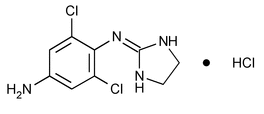Apraclonidine Hydrochloride
(a'' pra kloe' ni deen hye'' droe klor' ide).
1,4-Benzenediamine, 2,6-dichloro-N1-2-imidazolidinylidene-, monohydrochloride.
2-[(4-Amino-2,6-dichlorophenyl)imino]imidazolidine monohydrochloride
» Apraclonidine Hydrochloride contains not less than 98.0 percent and not more than 102.0 percent of C9H10Cl2N4·HCl, calculated on the dried basis.
Packaging and storage—
Preserve in tight, light-resistant containers.
pH  791
791 :
between 5.0 and 6.6 in a solution (1 in 100).
:
between 5.0 and 6.6 in a solution (1 in 100).
Loss on drying  731
731 —
Dry it in vacuum at 105
—
Dry it in vacuum at 105 for 3 hours: it loses not more than 1.0% of its weight.
for 3 hours: it loses not more than 1.0% of its weight.
Residue on ignition  281
281 :
not more than 0.1%.
:
not more than 0.1%.
Heavy metals, Method II  231
231 :
0.002%.
:
0.002%.
Chromatographic purity—
Phosphate buffer—
Transfer 6.8 mL of phosphoric acid to a 2000-mL volumetric flask, add about 1900 mL of water, and mix. Adjust with sodium hydroxide solution (1 in 2) to a pH of 3.0, dilute with water to volume, and mix.
Mobile phase—
Prepare a filtered and degassed mixture of acetonitrile, Phosphate buffer, and methanol (56:40:4). Make adjustments if necessary (see System Suitability under Chromatography  621
621 ).
).
System suitability solution—
Prepare a solution in Mobile phase containing about 0.8 mg of USP Apraclonidine Hydrochloride RS per mL.
Test solution—
Transfer about 20 mg of Apraclonidine Hydrochloride, accurately weighed, to a 25-mL volumetric flask, dissolve in and dilute with Mobile phase to volume, and mix.
Chromatographic system
(see Chromatography  621
621 )—The liquid chromatograph is equipped with a 220-nm detector and an 8-mm × 100-mm column that contains packing L7. The flow rate is about 3 mL per minute. Chromatograph the System suitability solution, and record the peak responses as directed for Procedure: the tailing factor for the apraclonidine peak is not more than 2.2, and the relative standard deviation for replicate injections is not more than 2.0%.
)—The liquid chromatograph is equipped with a 220-nm detector and an 8-mm × 100-mm column that contains packing L7. The flow rate is about 3 mL per minute. Chromatograph the System suitability solution, and record the peak responses as directed for Procedure: the tailing factor for the apraclonidine peak is not more than 2.2, and the relative standard deviation for replicate injections is not more than 2.0%.
Procedure—
Inject about 20 µL of the Test solution into the chromatograph, record the chromatogram, and measure the areas for the major peaks. [note—Allow about five times the elution time of apraclonidine before making the next injection. ] Calculate the percentage of each peak, other than the solvent peak and the apraclonidine peak, in the specimen of Apraclonidine Hydrochloride taken by the same formula:
100ri / rt
in which ri is the response of each peak other than the principal peak, and rt is the sum of the responses of all of the peaks, excluding that of the solvent peak: not more than 1.0% for any individual impurity and not more than 2.0% total impurities are found.
Assay—
Dissolve about 125 mg of Apraclonidine Hydrochloride, accurately weighed, in 40 mL of glacial acetic acid. Add 10 mL of mercuric acetate TS, and titrate with 0.1 N perchloric acid VS, determining the endpoint potentiometrically from the second inflection point, using a calomel-glass electrode system (see Titrimetry  541
541 ). Perform a blank determination, and make any necessary correction. Each mL of 0.1 N perchloric acid is equivalent to 14.08 mg of C9H10Cl2N4·HCl.
). Perform a blank determination, and make any necessary correction. Each mL of 0.1 N perchloric acid is equivalent to 14.08 mg of C9H10Cl2N4·HCl.
Auxiliary Information—
Please check for your question in the FAQs before contacting USP.
| Topic/Question | Contact | Expert Committee |
|---|---|---|
| Monograph | Elena Gonikberg, Ph.D.
Principal Scientific Liaison 1-301-816-8251 |
(SM32010) Monographs - Small Molecules 3 |
| Reference Standards | RS Technical Services 1-301-816-8129 rstech@usp.org |
USP35–NF30 Page 2234

